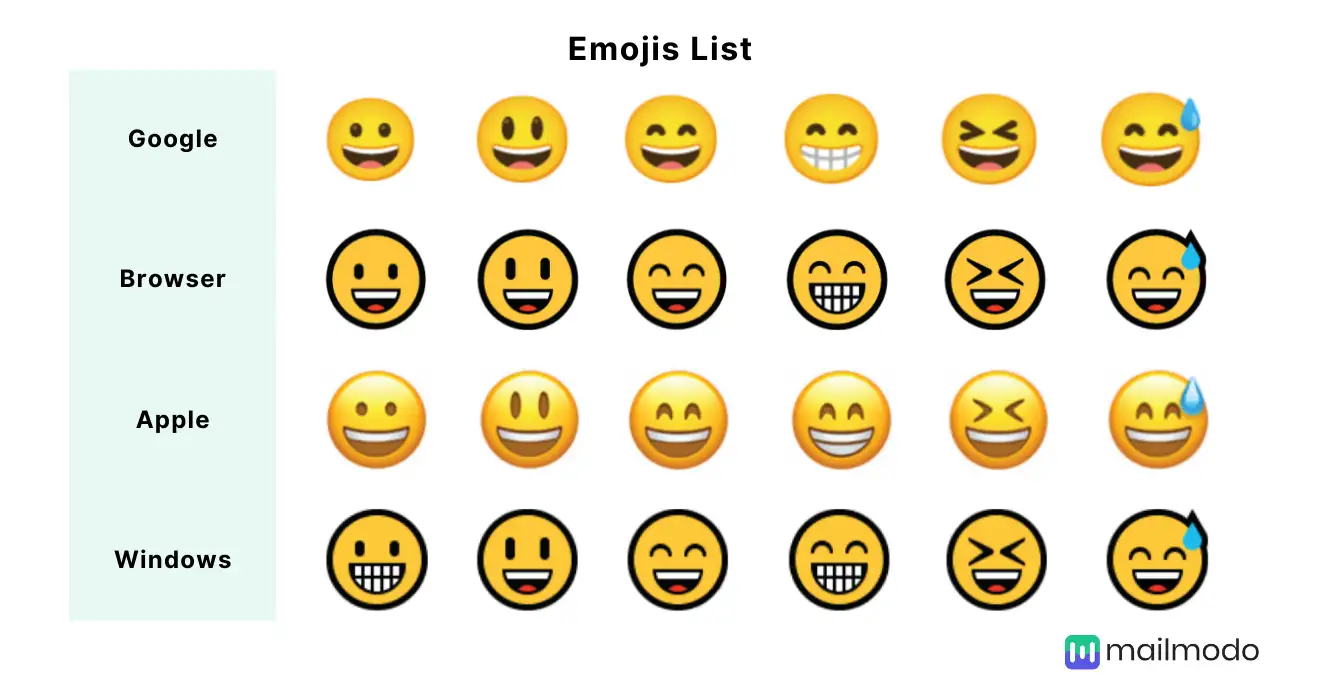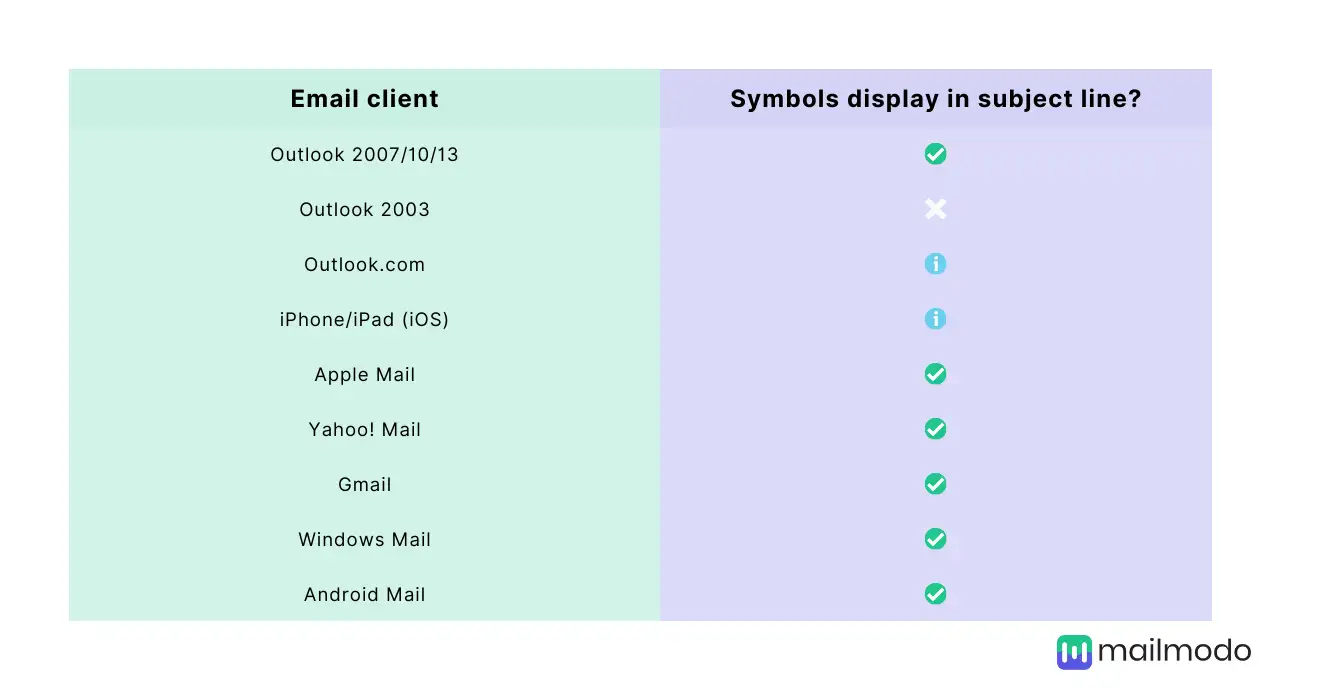Emojis in emails are like the parsley 🍃 on top of the gravy 🍲.
They help garnish and spruce up an ordinary email. However, as Goldilocks said, too much or too little is not good, and it has to be just right.
So, here we'll tell you how to dress up your emails with emojis and use just the right amount of them in your emails.
Table of contents
What are emojis 🤔?
Emojis are graphic symbols used to illustrate faces or objects for digital communication. The word "emoji" was coined from two Japanese words, "e" (絵), which means "picture" and "moji" (文字), which means "character."
When communicating through digital means, you can use them to express emotions like happiness, distress, relief, or even sarcasm.
For example, when you want to thank your customer for their review, you can say," I'm so glad you love the product 🥰."
What are the advantages of using emojis in your emails?
Emojis are creative forms of expression, and there are many reasons why using emojis in your emails can be helpful. Here are some of the benefits:
Helps you express yourself better 💁♀️
When you are writing an email, there is only so much you can express using just words. Emojis help showcase your personality to the reader.
For example,
Subject line: Chloe, there is a DEAD link on your page 🙀
Increases open rate and readability 👀
Emojis in the subject line grab the readers' attention and entice them to open the email, which helps increase the open rates.

And, according to a paper from the American Psychological Association, information containing emojis is easier to understand than the exact text without emojis.
Showcases brand personality💃
Brands often fall into the trap of seeming cold and unapproachable. But using emojis to express your emotions helps to humanize the brand and make it more honest and approachable. Emojis help in showcasing your fun or witty personality, which makes clients better connect with you.
How can you use emojis in an email?
Here we'll cover how you can use emojis in marketing emails and professional emails.
How to use emojis in email marketing
Marketers are already jumping on the trend of using emojis in emails. They are incorporating emojis to either replace or complement words creatively in a way that engages and connects with their readers.
1. Emojis in subject line 📥
In email marketing, emojis are most commonly used in the email's subject line as they help enhance subject lines and showcase the brand's personality.



Sales, product launches, holidays, or announcements are a perfect time to use emojis as they catch the viewer's attention amongst a sea of emails in their inbox.
For example, the subject line "Hot summer sale 🔥🔥🔥" is much more fun to read than just plain old "Hot summer sale" while conveying the point of the email.
Word of Advice: Don't go overboard with using emojis in the subject line, as you can risk irritating your readers, coming off unprofessional, or even getting marked as spam.
2. Emojis in the email copy📝
You can use emojis to convey a light-hearted, playful, or personal message in your email copy that coaxes customers to click through. However, make sure you use emojis to complement your text rather than replace them entirely with emojis.
Also, make sure that you don't use random emojis that have nothing to do with the content of the email, as it'll give rise to a bad user experience when they read the email.
- When is it appropriate to use emojis in email marketing?👍
If you send emails to millennials or gen z, then using emojis in your emails can make it more appealing to them as they use them constantly in their day-to-day conversations.
Emojis are also appropriate as long as they fit and enhance your brand identity. For example, if you are a small business selling handmade shoes, then using emojis like this 👠 👢🥿👟 will go with the brand identity and help enhance the text.
- When is it not appropriate to use emojis in email marketing?👎
Emojis might look cute, but they're not always appropriate.
But if you sell something like emergency supplies, medical equipment, or anything else that requires a more neutral tone, it's best to avoid using emojis in emails.
Moreover, if your customers tend to be part of an older demographic, they might not appreciate emojis as much as younger consumers would. So, for example, if you are to send an email about a Fixed deposit to your older audience, you can write" Be smart. Earn assured returns with FD/RD" instead of" Be smart. Earn assured returns 💸 with FD/RD".
3. Test the emails before you send the final campaign💯
Emojis might look the same across different email clients, apps, and OS, but you should still test to ensure no errors in rendering.

Not all email clients display all emojis, so it is crucial to test your emails for different email clients to prevent your emojis from appearing '☐' in the subscriber's inbox.

Also, in Gmail, the emoji in the subject line looks different in the inbox view compared to what it looks like after the email is opened.
Inbox view 👇

Email opened 👇

Apart from diagnosing any technical or rendering errors, A/B testing emails with emoji vs. emails without no emoji in the subject lines will tell how your subscribers will respond to the email.
How to use emojis in professional emails 👨💼
You can use emojis in a professional setting to help break down formal communication barriers to allow for more informal, personal conversations that are still professional.
Nowadays, many employees use emojis in their emails. This can be because a large percentage of the workforce is millennials who use collaborative communication tools like WhatsApp, Telegram, and Slack, which promote casual work interactions.
The use of emojis in work emails depends and can be inappropriate in certain conditions. Here are some of the things you need to keep in mind when including emojis in your emails.
- Context is important💼
Using emojis in a work email depends on the context of the email. For example, if you are sending a general email amongst your colleagues updating them about something, it might be alright to include emojis to make the email less boring.
However, if you are sending an important email to your boss, then it might not be the right time to incorporate emojis into it. If you want to know more about some etiquette to follow when writing an email, check out our article "Evolution of Email Etiquettes and Tips to Write Better Emails."
- Know your audience 👧🏻👵🏻👩🏻
If you are emailing the person for the first time or emailing the boss, it's best to stay safe and not use emojis while writing the emails.
But, if you are sending emails to colleagues who are millennials or gen z, then you can send emojis without worrying too much about seeming unprofessional.
List of commonly used emojis📋
Phrasee has analyzed the use of emojis in email marketing and how they impart the email campaign. They found 15 of the most commonly used emojis for email marketing.
| Emoji | Use cases |
|---|---|
| ⭐️ | Promotional, announcements, updates |
| ❤️ | Anything related to love or Valentine's Day |
| ☀️ | Summer-related content like summer sales |
| 😍 | Emails expressing gratitude towards your subscribers |
| 🔥 | Trends or sales |
| ✉️ | General messages or updates |
| ✈️ | Emails with momentary information like sales, exclusive discounts |
| 🎁 | Personalized birthday emails |
| ✨ | Announcements, product launches, and news updates |
| 🎉 | Celebratory emails |
| ⏰ | Emails with time restrictions or urgent deadlines |
| ⚡️ | Emails containing valuable information or announcements |
| 🚀 | Growth-related content |
| 🙏 | Thank you emails |
| 📢 | Announcements |
| ✅ | Emails containing any actionable tips or information |
| 🛒 | Shopping related /eCommerce, abandoned cart |
| 🎯 | Results or success stories |
Wrapping up
Emojis are nice to use to make the email more enjoyable and help capture the reader's attention. But only use it when it is appropriate.
If you are a business and don't know if using emojis is right for you, experiment with it and see if it works out for you. And make sure you don't go overboard with using emojis and use them minimally.
Take advantage of the opportunity and start using emojis to attract your subscriber's attention before your competitors join the game. You can also use GIFs to liven up your emails, check out our article to find out how to use GIFs in emails.


